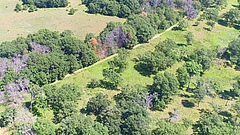Plant diversity may never fully recover from agriculture without a helping hand

Grassland at Cedar Creek, Minnesota (US) – one of the oldest fields in the upper left, and remnant savanna in the lower right. (Picture: Forest Isbel)
Even many years after being abandoned, plant diversity of former agricultural sites is still incomplete compared to undisturbed sites
Leipzig/Minnesota. Agriculture is considered a major disturbance for ecological systems – the recovery of degraded or formally used agricultural land might take a long time. However, without any active restoration interventions, this recovery can take an exceedingly long time and is often incomplete, as shown by a team of researchers led by the German Centre for Integrative Biodiversity Research (iDiv), Leipzig University (UL), Martin Luther University Halle-Wittenberg (MLU) and the Helmholtz Centre for Environmental Research (UFZ). Their study, which was published in the Journal of Ecology, sheds light on the recovery process at different scales in former agricultural sites, pointing to specific restoration interventions that could help biodiversity to recovery.
Land use such as transforming natural habitats into agricultural areas is the most important driver for biodiversity loss worldwide. However, one might assume that, given enough time, removal of major anthropogenic disturbances will allow biodiversity to recover. Ecological restoration is the science and practice of directing and speeding up the recovery of disturbed ecosystems. In accordance with Target 2 of the recently adopted Global Biodiversity Framework of the UN Convention on Biodiversity (CBD), at least 30% of areas of degraded terrestrial, inland water, and coastal and marine ecosystems should be under effective restoration by 2030.
To find out more about this recovery process in former agricultural sites, the researchers measured the recovery of biodiversity and species composition in 17 temperate grasslands in Minnesota (US). These grasslands were ploughed and used for agriculture, but different fields were abandoned between 1927 and 2015 so that natural succession and recovery of the vegetation could be followed. The researchers compared these abandoned sites to sites that were never ploughed, which acted as a reference and for what natural systems could look like. “What we wanted to know was how fast and how completely disturbed grasslands can regain their biodiversity if they are left to recover. Understanding that recovery process can give us insights into how we can assist and speed it up using restoration”, says first author Dr Emma Ladouceur from iDiv, MLU and UL, who is also a guest researcher at the UFZ.
After 80 years, species richness was still lagging behind
The researchers found that even after 80 years, the abandoned fields had not recovered on their own compared to never-ploughed sites. The number of different species in old fields was on average 65% of that in never-ploughed sites. In addition, the types of plant species that lived at the site recovered over time, but not completely. When the fields were first recovering, they were colonised by species that were unique to old field sites, like many weedy and disturbance-tolerant species. After some time, many species characteristic of the never disturbed sites colonized and increased through time. However, across the whole study, there were 63 native species unique to the never-ploughed sites, and the recovering old fields had more introduced grasses and weeds.
In their study, the researchers focused on the recovery of old fields without any active restoration efforts to promote this process. With the help of this information, restoration actions can be designed to help these systems better recover. “By looking closely at the recovery of species composition at different scales, we can get a better idea of what species could be targeted in restoration treatments, and how we could help these systems recover best”, explains co-author Prof Dr Stan Harpole, head of the Physiological Diversity research group at UFZ, iDiv, and MLU. “Specific restoration measures could include the seeding or planting of species that we know are not part of the composition of recovering fields, combined with the management of exotic species to reduce competition with native species”, adds Dr Emma Ladouceur.
Informed advice for policy
“With our study, we show that using valuable and rare data across a long-time scale and looking at important spatially-dependent patterns can lead to practical outcomes that are directly relevant for policy. For example, our results can be used to provide important context for understanding restoration outcomes and targets as part of international forums such as the recent United National Biodiversity Conference (COP15)”, says senior author Prof Dr Jonathan Chase, head of the Biodiversity Synthesis research group at iDiv and MLU.
This research was financed inter alia by the Deutsche Forschungsgemeinschaft (DFG; FZT-118).
Kati Kietzmann
Original publication
(iDiv researchers and alumni in bold)
Ladouceur, Emma; Forest, Isbell; Clark, Adam; Harpole, W. Stanley; Reich, Peter; Tilman, David; Chase, Jonathan (2023); The recovery of plant community composition following passive restoration across spatial scales. Journal of Ecology, DOI: 10.1111/1365-2745.14063
Contact:
Dr Emma Ladouceur
Postdoctoral Researcher in the Physiological Diversity & Biodiversity Synthesis Research Groups
German Centre for Integrative Biodiversity Research (iDiv) Halle-Jena-Leipzig
Helmholtz Centre for Environmental Research – UFZ
Alexander von Humboldt Foundation
Martin Luther University Halle-Wittenberg
Leipzig University
Phone: +49 341 9733255
Email: emma.ladouceur@idiv.de
Prof Dr Jonathan Chase
Head of the Biodiversity Synthesis research group
German Centre for Integrative Biodiversity Research (iDiv) Halle-Jena-Leipzig
Martin Luther University Halle-Wittenberg
Phone: +49 341 9733120
Email: jonathan.chase@idiv.de
Web: www.idiv.de/en/groups-and-people/core-groups/synthesis.html
Dr Volker Hahn
Head of Media and Communications
German Centre for Integrative Biodiversity Research (iDiv) Halle-Jena-Leipzig
Phone: +49 341 97 33154
Email: volker.hahn@idiv.de
Web: www.idiv.de/media
